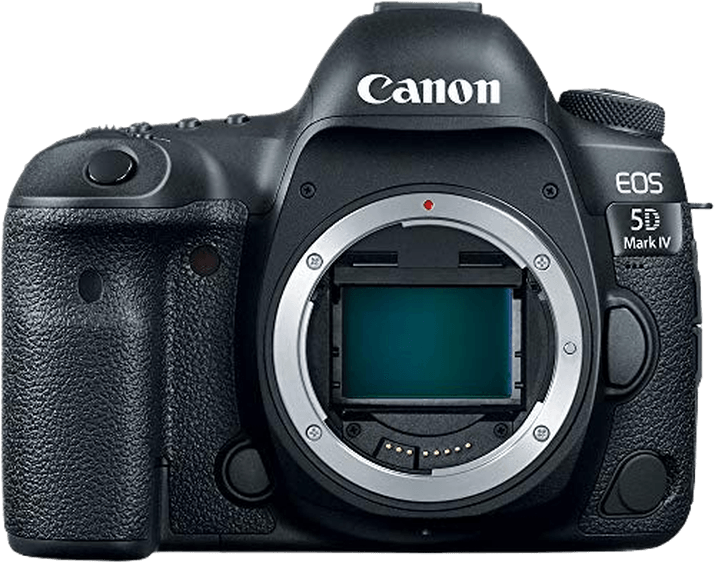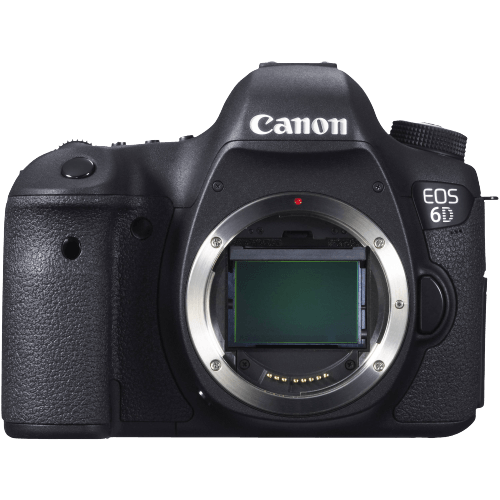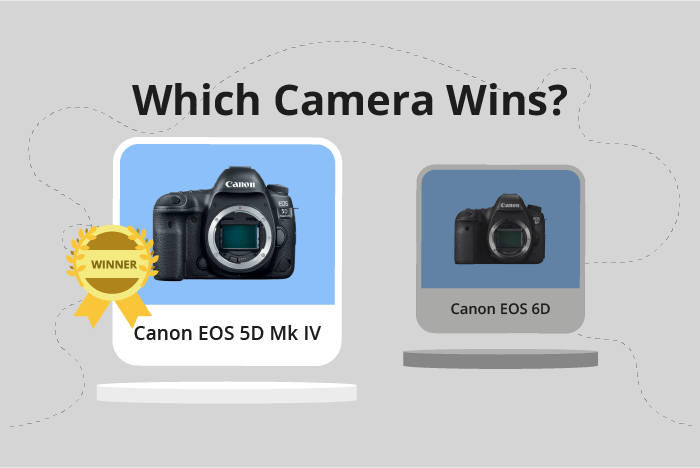Canon EOS 5D Mark IV vs EOS 6D Comparison
Canon EOS 5D Mark IV

Canon EOS 6D

The Canon EOS 5D Mark IV outperforms the Canon EOS 6D with a score of 75/100 compared to 59/100. Both cameras are DSLRs, released in 2016 and 2012 respectively. They share similar dimensions, with the 5D Mark IV measuring 151 x 116 x 76mm and the 6D measuring 145 x 111 x 71mm. The 5D Mark IV weighs slightly more at 890g, while the 6D weighs 770g.
The 5D Mark IV’s higher score highlights its superior features and overall performance. With a launch price of $3500, it offers more advanced technology than the 6D, which was launched at $2099. However, the 6D’s lower price and lighter weight make it more accessible and convenient for those with budget constraints or who prioritize portability.
Considering the differences in scores, specifications, and release dates, the Canon EOS 5D Mark IV is the better camera, offering enhanced capabilities for professional photographers. On the other hand, the Canon EOS 6D is a more affordable and portable option for casual users or those new to DSLR photography.
Canon EOS 5D Mark IV vs EOS 6D Overview and Optics
The Canon EOS 5D Mark IV emerges as the winner in the optics comparison with a score of 76/100, while the Canon EOS 6D trails behind with a score of 61/100. Both cameras share similarities in specifications, such as having a CMOS sensor, full-frame sensor size, Canon EF lens mount, and no image stabilization.
The 5D Mark IV outshines the 6D with its higher megapixel count of 30.4, compared to the 6D’s 20.2. This results in superior image quality and resolution. Additionally, the 5D Mark IV boasts a faster shooting speed of 7 frames per second (fps), which is beneficial for capturing fast-moving subjects or action scenes, while the 6D offers a slower 4.5 fps. The 5D Mark IV also features a more advanced Digic 6+ processor, which enhances the camera’s performance, and a higher DXOMARK sensor score of 91, indicating better overall image quality compared to the 6D’s Digic 5+ processor and DXOMARK sensor score of 82.
However, the Canon EOS 6D does have some advantages over the 5D Mark IV. Its lower megapixel count may result in better low-light performance and less noise in images. Furthermore, the 6D’s lower score and fewer advanced features may make it a more budget-friendly option for photographers who do not require the additional capabilities offered by the 5D Mark IV.
Taking into account these differences, the Canon EOS 5D Mark IV is the superior choice for photographers seeking higher resolution, faster shooting speed, and better overall image quality. On the other hand, the Canon EOS 6D may be a more suitable option for those prioritizing low-light performance and budget considerations.
Canon EOS 5D Mark IV vs EOS 6D Video Performance
The Canon EOS 5D Mark IV outperforms the Canon EOS 6D in video capabilities, scoring 91/100 compared to the 6D’s 43/100. Both cameras share some common specifications, but the 5D Mark IV’s advanced features make it the superior choice for video recording.
Both the 5D Mark IV and 6D can record video, but the 5D Mark IV has a higher maximum video resolution of 4K, while the 6D is limited to Full HD. This results in the 5D Mark IV producing videos with significantly more detail and clarity. Furthermore, the 5D Mark IV supports a maximum video frame rate of 120fps, allowing for smooth slow-motion footage. In contrast, the 6D’s maximum frame rate is 30fps, which restricts its ability to capture fast-moving subjects or create slow-motion effects.
The 5D Mark IV also includes built-in time-lapse functionality, enabling users to create stunning time-lapse videos without the need for additional equipment. The 6D lacks this feature, making it less versatile for dynamic video content.
There are no notable areas where the 6D outperforms the 5D Mark IV in video capabilities. The 5D Mark IV’s higher resolution, faster frame rate, and built-in time-lapse functionality make it the clear winner.
Considering these points, the Canon EOS 5D Mark IV is the better choice for video recording due to its advanced features and superior performance. The Canon EOS 6D, while still capable of recording video, does not offer the same level of quality and versatility as the 5D Mark IV.
Canon EOS 5D Mark IV vs EOS 6D Features and Benefits
The Canon EOS 5D Mark IV outperforms the Canon EOS 6D with a feature score of 74/100 as opposed to the 6D’s 57/100. Both cameras share common specifications, such as a lack of flip screen, the presence of GPS and WIFI, and the absence of Bluetooth connectivity.
The 5D Mark IV has superior features, most notably its screen size and resolution. The 3.2-inch screen is larger than the 6D’s 3-inch screen. Additionally, the 5D Mark IV has a higher screen resolution of 1,620,000 dots, compared to the 6D’s 1,040,000 dots. This means that the 5D Mark IV offers a clearer, more detailed display. The 5D Mark IV also has a touchscreen, which the 6D lacks, making it more user-friendly and convenient for photographers.
On the other hand, the 6D has no significant advantages over the 5D Mark IV in terms of features. The only common ground between the two cameras is the absence of a flip screen and Bluetooth connectivity, as well as the presence of GPS and WIFI. However, these similarities do not make the 6D a better option.
Considering the clear differences in feature scores and specifications, the Canon EOS 5D Mark IV is the superior camera in comparison to the Canon EOS 6D. The larger screen, higher screen resolution, and touchscreen functionality make the 5D Mark IV a more user-friendly and efficient option for photographers. While the 6D shares some common features with the 5D Mark IV, it fails to offer any significant advantages, making the 5D Mark IV the better choice.
Canon EOS 5D Mark IV vs EOS 6D Storage and Battery
The Canon EOS 5D Mark IV outperforms the Canon EOS 6D in storage and battery with a score of 71/100, compared to the latter’s 45/100. Both cameras share common specifications such as accepting SD, SDHC, and SDXC memory cards and lacking USB charging.
The 5D Mark IV has an advantage in storage with two memory card slots, accepting both SD (UHS-I compatible) and Compact Flash cards. This allows for more storage capacity and flexibility when shooting. However, the 6D has a longer battery life, offering 1090 shots compared to the 5D Mark IV’s 900 shots. Despite this, the 5D Mark IV uses the more advanced LP-E6N battery type, which may provide better overall performance.
While the Canon EOS 6D boasts a longer battery life, the 5D Mark IV’s superior storage options and advanced battery type make it the better choice for photographers seeking optimal storage and battery performance.
Canon EOS 5D Mark IV vs EOS 6D – Our Verdict
Are you still undecided about which camera is right for you? Have a look at these popular comparisons that feature the Canon EOS 5D Mark IV or the Canon EOS 6D:

